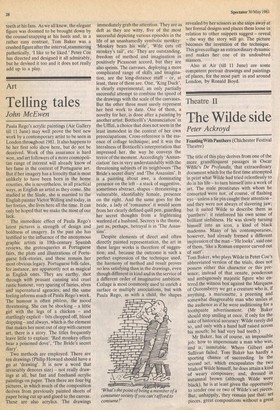ARTS
The great Dane
Mark Amory
Hamlet (Theatre Royal, Stratford East) Feasting With Panthers (Chichester Festival Theatre) Lindsay Anderson is among the three or four most known and admired directors in Britain. Foreigners ask why we have allowed years to go by since his last film, 0 Lucky Man, which betrays their ignorance of how things are ordered round here. Faithful readers may remember a row between the Royal Court and the Spectator theatre critic which led to a threat to their grant and the hysterical reaction from Anderson: 'The tanks are rolling in on Sloane Square.' He did not work at the National Theatre at first and demanded, 'What do they expect me to do? Crawl across Waterloo Bridge on my knees?' Now the film industry and the National are eager to employ him, but he has fitted in his first Shakespearian production since Julius Caesar in 1964 with a little-known company headed by an actor who is practically his own invention. That is no slur on Frank Grimes, but it is true that four of his six (I think) London performances have been directed by Anderson. You might expect a classic piece of 'director's theatre'; in fact you get the exact opposite.
This is the sort of production that many people, particularly older people, are always saying they want. There is little conspicuous invention and it seems likely that much of that had necessity as one of its parents. Three off-white columns form the set with few additions, but Jocelyn Herbert has always believed in the spare, less-ismore approach. The costumes are colourful rather than magnificent and have a slight suggestion of the dressing-up trunk in the attic. The Danish court has a domestic atmosphere with few strangers intruding; we are a long way from the budget and style of the Royal Shakespeare Company who believe in establishing a context by evoking a whole society. The verse here is spoken simply and with impressive clarity rather than held up and examined for new subtleties. Above all there are no attempts at a startling originality. The play's the thing and it is not placed in Vietnam or 1914 or before sets in the style of Salvador Dali; nor is Ophelia pregnant or Osric a dominating manipulator or the ghost played by a laser beam.
These are negative qualities, throwing the burden of the evening on the actors. Could they carry it? Well, yes and, in some cases, no. After some rather ineffective what ho-ing on the battlements with a ghost who simply shone a torch at his chin, we discovered a Hamlet whose eyes were red and whose voice was harsh, perhaps with weeping. He seemed a nice boy and was accepted by his family and friends as little more, certainly no match for Claudius and the world. The quicksilver mind that makes Hamlet so charming was not much in evidence; he could not even summon up much enthusiasm when offering his friends a drink; perhaps the actor was in the grip of first-night nerves. But it is into Hamlet and not Grimes that confidence flows as the evening progresses and he achieves the quality of being not-boring, easy-to-watch as a book can be easy-to-read. A shade disturbed but far from mad, he is allowed a rare explanatory gesture when he pats Horatio to reassure him that his oddness is assumed. While he becomes formidable he remains curiously simple, the celebrated complexities are more ignored than motivated and do indeed seem to a large extent to melt away.
Though the play still runs for three and a half hours it seems to bowl along, an exciting story lucidly told, sagging only when Hamlet is off-stage in the second half. Tom Stoppard has distinguished Rosencranz and Guildenstern, but I muddled them up again — the one I liked had the quick, weak smiles of a born courtier. The grave-digger got laughs, but so did Claudius. Laertes was less priggish than usual and courageous in the flashing fight at the end.
There is a moment when Hamlet in conversation with the ghost turns away to address us, his father replying over his son's shoulder. This unlikely positioning is often used on television where at least it has the understandable motive of allowing us to see two faces in close-up. It is sometimes known as 'The shot that dare not speak its name'. On the Chichester train to see the originator of the phrase (Bosie not Oscar) in Feasting With Panthers, I was full of forboding. The text is taken from the court appearances of Wilde, Act One when he is suing the Marquess of Queensberry for libel, Act Two when he is charged with homosexual offences. So in fact Bosie scarcely appears. Trial scenes are said to be sure-fire in the theatre. Not with me. I go pale with boredom whenever I hear a bewigged figure say, 'I put it to you that on the night of the 14th . . .° Also, Wilde's story is too familiar, and the idea of getting Dr Who to play him seemed a gimmicky attempt to pull in a television audience while giving Tom Baker a little prestige. In the event it was this casting that worked best. Oscar Wilde was a star and it was apt that his entrance was applauded and he followed his best lines with a complacent flash of his glittering teeth at his fans. As we all knew, the elegant figure was doomed to be brought down by the counselsnapping at his heels and, in a rather easy contrast, Tom Baker was a crushed figure after the interval,stamme ring pathetically, 'I like to be liked.' Peter Coe has directed and designed it all admirably, but he devised it too and it does not really add up to a play.











































 Previous page
Previous page